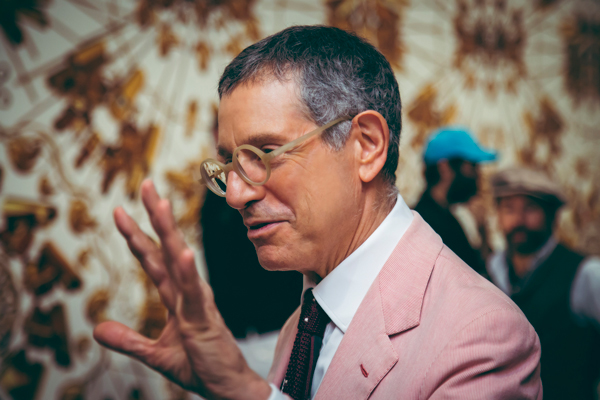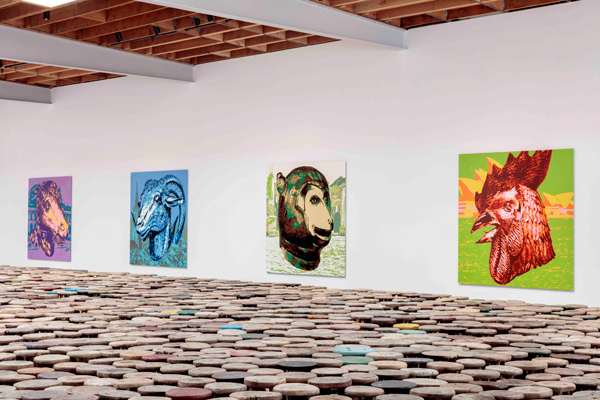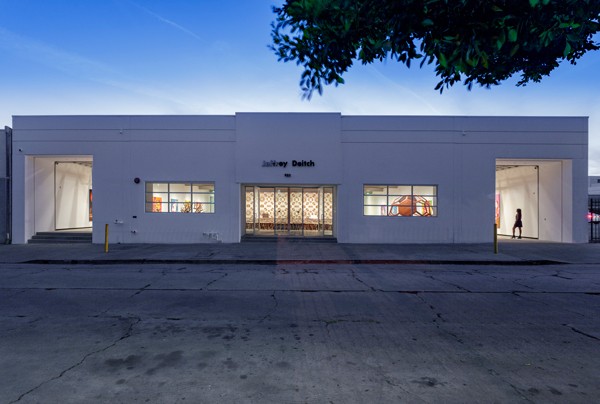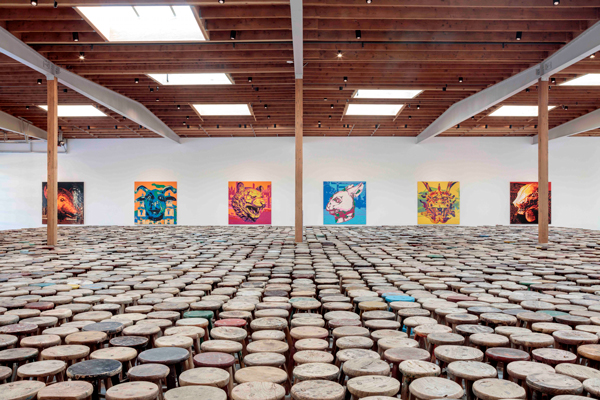“People I have great admiration for, people in my own circle, they just keep coming to Los Angeles. All the key people, and they just keep coming,” says art dealer Jeffrey Deitch at his Los Feliz home. “It never stops. And now we have reached critical mass. It’s no longer, ‘Wow, things are happening here.’ It’s now. It’s real.”
We are in the kitchen of the house Deitch bought back in 2010, when he became the director of the Museum of Contemporary Art (MOCA). He’d been coming to LA for decades before, and that didn’t slow after his early departure from MOCA. No wonder he kept the house, it’s a treasure: a Spanish Colonial with a terraced view from the hills south across the middle of the city, original stained glass and tiles, and chock-full of his wildly eclectic art collection.
It’s not the pageant of splashy masterpieces you might expect. It’s not a collection staged for showing off, but rather the home of a man who lives with art in an organic, almost casual way. It’s everywhere you look, sometimes competing with the fanciful architecture for attention. With the exception of a colorful large-scale sculptural tableau that dominates one end of the living room, most of the work, even the larger pieces, are quite subtle from a distance. Muted palettes and schematic abstractions radiate the downtown nightclub conceptualism of New York in the ’80s. Even the occasional Warhols are clearly personal favorites rather than chart-toppers.

Jeffrey Deitch at the 1point8, photo by Carlos Gonzalez
Deitch greets me at the gate, and although it’s a Sunday, he’s in uniform—signature round spectacles, tan trousers, blue dress shirt. We are barely in the door before he offers me a coffee, which he makes himself with an old-school Italian moka pot. When it’s ready, he leads me across the wide main room and out to a glassed-in porch with a wrought-iron mosaic table, loads of potted plants, abstract sculptures and a commanding view of the city to the south. He sits across from me, and visibly relaxes. It’s time to get into it.
We are here to talk about his long and storied history with Los Angeles, as he enters a new chapter of his career as an LA gallerist. His eponymous space in Hollywood, near Santa Monica and La Brea, opened in September with a blockbuster Ai Weiwei exhibition, and I have questions. Why LA? Why now? Why La Brea Ave? (So many reasons.) What is his life like now that he’s bicoastal again? (He goes back and forth every few weeks.) What does he think about Frieze coming here? (He loves it.) What did he take from his experience at MOCA that changed how he views the city, or affects how he approached the new franchise? (You might be surprised.)
“New York City is a business center,” he says. “And in order to be on the edge of what I do artistically and be on top of my business, New York is essential. But LA, besides having arguably the world’s best climate and all the obvious things about the lifestyle—besides that, what I’ve seen over the last eight years is this really astonishing convergence of creative energy.” Noting a marked acceleration in westward migration since 2010, Deitch adds with no modesty at all, “A number of people say that I helped with that. And I may have.” Perhaps arguable, but it’s certainly true that the international art media followed him like a press corps and in some ways, they never really left, either.
Deitch’s New York gallery has always taken SoCal and San Francisco art seriously, especially street culture and its influences. He was showing Shepard Fairey and Barry McGee (from the Bay Area) before just about anyone in New York, and before that, he become fascinated by the generation of artists that included Paul McCarthy, Mike Kelley and Charles Ray. “My ‘Post-Human’ show in 1992 went to five museums in Europe and the Middle East,” he boasts. “So I have a lot of deep friendships here. The gallery has always had an open global vision and that will continue.”
So then why the decision to open a new space here, now, I ask. “The main reason to do this gallery is that in New York I have 5,000 square feet—which is big for New York, but not big enough for the ambitious shows I want to do.” Deitch goes on to explain that a big reason he went to MOCA in 2010 was that rather than doing monthly show after monthly show by his own gallery artists, he had wanted to be able to go beyond that in scale and scope, and to work thematically. This curatorial approach, while not particularly well-suited to the more constrained administrative role of a director, stayed with him. When it came time to expand the gallery, he looked at Brooklyn. “But I realized,” he says “that I should be doing this in LA, and this space came together.”

Ai Weiwei, Zodiac, installation view, Jeffrey Deitch, Los Angeles, 2018, photo by Joshua White.
That was part of the idea behind launching with the Ai Weiwei show. “He is a great and truly international artist,” says Deitch. “I wanted to open with an artist whose audience is beyond the insider art world. It’s very moving, all day long we get these calls asking about the admission charge or getting tickets from people who may never have visited a gallery before.” Deitch is a great admirer of Ai, and the artist’s willingness to “take on this moral voice, to address issues of great concern to the world in an engaged and serious way. Particularly now, for me it’s very important.” And yes, the work has an element of spectacle, and even Pop, in the 6,000 stools and lego-based wall pieces. But it’s also heavy, and dark at times—and that’s kind of Deitch’s sweet spot.
“When I was at MOCA, because I did a few fun projects, they laid on this thing that I’m not serious. Okay, if that’s what you want,” Deitch says with a shrug and a smile. “I’ve never had a problem with having fun. I embrace all sides of life.” He reflects on artists like Warhol who were big inspirations to him, in art and in life. “Andy was in praise of having fun and doing crazy things, but when we look back we see that he presented both the highlights and the tragedy of his time.” In that spirit, at MOCA, Deitch tried to emphasize underground culture, working on projects about Marjorie Cameron and Jack Parsons, Kenneth Anger, and the influence of say, George Herms, on younger artists. “It’s not noir per se, I’m very interested in the darker counter-culture. I love the history.”

Jeffrey Deitch Hollywood gallery facade; photo by Joshua White
Coincidentally, the part of Hollywood where he hung his shingle—on Orange Drive, a busy side street in the Hollywood Media District—is home to old film and music studios like Paramount, where Frieze will be this February. A lot of that activity is coming back, like Sirius Radio and Just One Eye. And of course, other galleries, including LAXART, Regen Projects, Kohn Gallery, Shulamit Nazarian, KP Projects, Tonya Bonakdar, Steve Turner, Diane Rosenstein and others are all within walking or easy driving distance. “I love historical neighborhoods,” he coos. “I’m one of the few that stayed in SoHo. But I didn’t want to be in an art mall, I wanted restaurants and stores and music and pedestrians, and a street life outside the doors.”
“I developed great relationships when I was here at MOCA.,” he tells me. “And the LA art market really has the potential to become international. I see it already. Important collectors from China, Europe and New York are coming here regularly, visiting studios, galleries and private collections; and the museums and non-profits here have excellent programs and are developing patrons. But serious things take time to develop.”
As one might expect, Deitch is excited about Frieze, and not just because it’s in his new backyard. He will have a booth there and has been very involved in establishing it here. “That’s one of the other elements coming together,” he says. “There’s never been this kind of important international art fair here, and everyone wants to be a part of it. It will be a great experience for people coming from other cities.”
Does the fact that Frieze is taking a chance with their fair in LA mean that LA collectors might be emerging as a stronger base, as opposed to collectors still buying in New York? Deitch maintains the fairs can’t go wrong here: “There is a tremendous interest in collecting here. We are all excited about strengthening the art market here as well as the creative discourse, and it’s clearly happening. My approach to business has never been transactional, to sell something, get the highest price and move on. No, it’s about developing long-term relationships. I have multi-generation friendships within families of collectors, where I sold to their grandparents, their kids, and now it’s the grandchildren. It’s a beautiful thing.”


